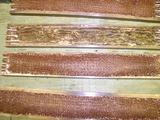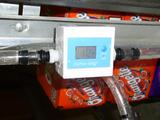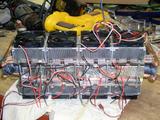wow that is one awesome sandwich. 14 TECs, and both WC and air on the hot side - amazing.
You didn't say how you plan to power the TECs. That will make a difference in the performance, obviously. My guess is your heat sinks have performance of around .3C/W, so 4 on the hot plate gives you .075C/W, not bad at all. That will certainly reduce the load in your hot side loop.
Running those 12706 TECs as 7 series pairs, you will have 6V on each TEC and be at CoP of 1.8 on the 10C dT curve, and 1.3 on the 20C dT curve, pretty decent. That puts you at 2.25A. That's 13.5W in per TEC, or a total of 94.5W per side. You move 170W across dt of 10C, for total heat load of 265W, and 123W across 20C, for total heat load of 217W.
Hard to say what the thermal performance of the hot side loop is, but my guess is the plates themselves have maybe .035 or a little less. From the excellent write-up at
http://www.xtremesystems.org/forums/...ad.php?t=77260
we know that the PA120 has performance between .03C/W and .02C/W for higher CFM. So you could get to a total of .055C/W from the hot side of the TEC to ambient. I'm assuming you have a separate pump and rad for each side based on the no holds barred way you did the rest of this.
There is a lot of thermal interface to consider in your sandwich, but if we take the combined cooling of both the air and water, you get to maybe .035 as total thermal resistance to ambient. That should give us some idea of where the hot side will be, and how much heat you move. Looking at the 10C dT TEC numbers, the 265W heat load will put the hot side at 8.6C above ambient, so that's probably close to where you will be when you first start things up.
You will be pulling a total of 340W out of the cold side loop, which will drop water going through the cold side chamber about .7C per second at 2GPM. As long as your total heat load in the cold side is less than 340W, the temp will continue to drop. But as it does, the TEC moves less power, since dT increases.
At dT of 30C, your TECs will move a total of 140W. That puts your hot side about 6C above ambient with your cooling, so if the heat load is less than 140W, you will stabilize at around 1C. If the heat load is higher, it will stabilize a little higher. Still, those are pretty good numbers.
If you are game to do either a chopper supply or a bang-bang controller for the TEC power, you could run off the 12V line and control power based on cold side temp. At startup, with 12V, you have about 390W in per side, and move 290W per side. The total heat load is 680W per side, which gives you a rise of 22C with your cooling. But you are pulling 580W out, which drops the temp at over 1.1C per second. With that much power, you can dial in almost any cold side temperature - you can move 170W at 50C dT, which puts you at -5C or so with 25C ambient.
If you need any help with a power controller, I'll be glad to help. With the cooling power you have available, that seems like the way to go if you want sub-zero.
.



















 Reply With Quote
Reply With Quote






Bookmarks